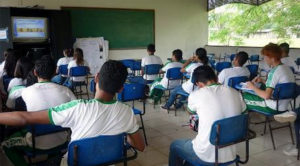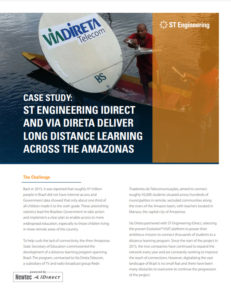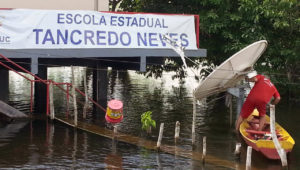In 2015, we started working with Via Direta, a subsidiary of TV and radio broadcast group Rede Tiradentes de Telecomunicações, on the largest distance learning network in Brazil. Based on the ST Engineering iDirect Evolution platform, we developed an IPTV distance learning solution that can accommodate interactive learning, connecting the remotest villages and ensuring that children and young people receive an education.
The network now stands at 1070 sites and this is soon set to increase to 1200, with plans to upgrade existing and new sites with the iQ Desktop+ modem.
We were delighted to get the opportunity to speak to Via Direta’s owner, Ronaldo Tiradentes, to find out more about the critical role that this network plays to children and the wider community.
How critical is this network to the children and young people of the Amazonas region? Can you give us an idea of how the network has changed their experience of education?

Back in 2007, SEDUC invested in the construction of a specialized ‘Midia Center’ (Media Center), which is a building with several identical studios equipped with everything required to create video classes. However, at that time, the existing network was unreliable and Via Direta started work with ST Engineering iDirect to improve and expand it.
Each remote classroom was equipped with a large flat screen TV, PC with webcam plus microphone, printer (to print tests and other classwork), ST Engineering iDirect’s X1 satellite modem, networking and UPS or generator equipment.
Students that attend these remote schools are assisted by a tutor, who handles the equipment and facilitates the live exchanges between remote schools and SEDUC teachers at the Media Center (CEMEA).
We know that we are providing a very critical service to the people of Amazonas, because for many, this network is the only connection available to the outside world. There is nothing else available! Their only alternative is to travel for days until they reach a bigger town, up or downriver.
How has the network been received by the people of the Amazonas? What kind of feedback have you had about the network and how is it impacting the lives of young people?
For many communities spread over the network of rivers and forests that make up the Brazilian state of Amazonas, there is no alternative way to attend school.
The people are truly thankful and take great care of the equipment. The network link is viewed as a basic need, often vital for the entire community, and it is used in ways that were not originally intended. For example, in absence of cellular coverage, the embedded chat tool is used to exchange messages between communities that are days apart by river travel. They keep up with distant family members, request favors and exchange valuable information between communities. They realize the benefits of a reliable satellite connection.
The feedback is very positive, and we are very sensitive to the dramatic and profound impact it has over these remote communities, so we do our best to keep everybody connected. We are fully aware that the linked communities also use the service to request medical help, order supplies, get news updates, receive social services, but also to socialize. We even had marriage proposals over satellite link, right at the beginning of the pandemic. Even with the classes suspended due to COVID-19, we kept the network running because of the important lifeline it represents for our people.
How big is the network?

It is the largest public schooling network promoted by a Department of Education, in this case, SEDUC of Amazonas. Their latest estimate is that over 200,000 students depend exclusively on this network to receive basic education at all levels, and to prepare to the ENEM exam (Brazilian National High School Evaluation), roughly comparable to US College Entrance Exams.
Can you sum up your experience of working with iDirect on this project?
The partnership with ST Engineering iDirect has been the cornerstone of our project. We simply could not have done this without their direct input and experience. The local team was hugely supportive. We flew up to the ST Engineering iDirect HQ in Virginia to meet their team in person, filled out the initial paperwork and closed the deal that really started the project.
From that moment forward, we have worked exclusively with ST Engineering iDirect. We have received a lot of help over the years, not only with planning and procurement of all teleport and hub-equipment, but also with overall maintenance, planning & execution, troubleshooting and operation!
We are very thankful for receiving great professional assistance, which always went above and beyond their hub equipment responsibilities.
As our trust grew and the relationship deepened, we contracted Professional Services & Engineering to help us with maintenance needs, hardware and software updates. We take all the exchanges, advice and recommendations very seriously. We are sure that without this partnership we would not have been able to renew our service contract with SEDUC. ST Engineering iDirect can be very proud of that!
What has our technology enabled you to achieve?

We learned from ST Engineering iDirect about available technologies that we could leverage, such as SatMotion Pocket, which enabled us to migrate 600 sites in less than 60 days without the need to call the satellite operator each time to repoint a dish and run tests. Another strategic technology we bought was the L-band PCMA setup, for frequency-reuse. This recommendation allowed us to save up to 40% in satellite bandwidth spectrum without any negative impact to our services’ availability. Needless to mention, the PCMA setup paid for itself well within the initial few months of operations. Thanks to those technological ingredients, we have developed a recipe for steady growth and stability. We couldn’t be happier with the results from our decisions!
How do you see the future of the network?
ST Engineering iDirect enabled us to create a local operation that is efficient in enabling long distance learning in a very meaningful way.
We see this network still growing steadily, not only in size, but also in importance. We receive constant growth and modernization requests and it is not always easy to keep up with the demand. To date, we have connected 1070 sites, and in the immediate future we expect to grow by 130 sites, reaching 1200 connected Ku-band schools by the end of 2021. On top of this, we have also deployed a C-band network that is focused on a high-availability corporate network to connect several dozen-office sites throughout our vast state, and will invest in modernizing our hub equipment with newer servers and a brand new switching fabric. We have installed the latest Evolution software to enable us to take advantage of DVB-S2X in the future. Furthermore, we are starting to experiment with Ka-band internet services by connecting another 100 sites that will rely on a third satellite option. It rains quite a lot in our region and Ka-band services may not withstand our grade of storms.
We have been extremely pleased with our success, and we credit ST Engineering iDirect for a lot of the positive impact we are having on people’s lives!
